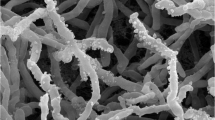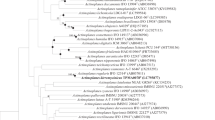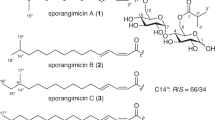Abstract
An actinomycete strain, designated MM04-1133T, was isolated from an anthill soil sample collected in Bagan, Myanmar. To establish the taxonomic status of this strain, the isolate was subjected to a polyphasic approach. Strain MM04-1133T was Gram-staining positive, aerobic, motile and formed long and narrow sporangia directly above the surface of the substrate mycelium. Whole-cell hydrolysates of the strain contained 3-OH-diaminopimelic acid, arabinose, glucose, galactose, mannose, rhamnose and xylose. The predominant menaquinones were MK-10(H6) and MK-10(H8). The major cellular fatty acids were iso-C16:0 and anteiso-C17:0. The diagnostic phospholipid was phosphatidylethanolamine. The G+C content of the DNA was 69.1 mol%. Phylogenetic analysis based on 16S rRNA gene sequence revealed that strain MM04-1133T clustered within the genus Virgisporangium, with the sequence exhibiting highest similarity (98.5% identity) with Virgisporangium ochraceum NBRC 16418T. The strain grew in the presence of 0–1% (w/v) NaCl, at pH 5–8 and at 20–40 °C, with optimal growth at 30–37 °C. Based on phylogenetic analysis and chemotaxonomic and phenotypic data, we propose classifying this isolate as a novel species of the genus Virgisporangium, to be designated as Virgisporangium myanmarense sp. nov. The type strain is MM04-1133T (=NBRC 112733T=VTCC 910008T).
Similar content being viewed by others
Log in or create a free account to read this content
Gain free access to this article, as well as selected content from this journal and more on nature.com
or
References
Tamura, T., Hayakawa, M. & Hatano, K. A new genus of the order Actinomycetales, Virgosporangium gen. nov., with descriptions of Virgosporangium ochraceum sp. nov. and Virgosporangium aurantiacum sp. nov. Int. J. Syst. Evol. Microbiol. 51, 1809–1816 (2001).
Otoguro, M. et al. Virgisporangium aliadipatigenens sp. nov., isolated from soil in Iriomote island and emended description of the genus Virgisporangium. Actinomycetologica 24, 39–44 (2010).
Genilloud, O. inBergey’s Manual of Systematic Bacteriology. 2nd edn Vol 5 (eds) Goodfellow, M. et al1039–1057 Springer, New York, NY, USA, (2012).
Muramatsu, H., Shahab, N., Tsurumi, Y. & Hino, M. A comparative study of Malaysian and Japanese actinomycetes using a simple identification method based on partial 16S rDNA sequence. Actinomycetologica 17, 33–43 (2003).
Hop, D. V. et al. Taxonomic and ecological studies of actinomycetes from Vietnam: isolation and genus-level diversity. J. Antibiot. (Tokyo) 64, 599–606 (2011).
Lisdiyanti, P. et al. Diversty of actinomycetes from soil samples collected from Lombok island, Indonesia. Ann. Bogorienses 16, 35–40 (2012).
Wolf, T. et al. Targeted genome editing in the rare actinomycete Actinoplanes sp. SE50/110 by using the CRISPR/Cas9 System. J. Biotechnol. 231, 122–128 (2016).
Baltz, R. H. Genetic manipulation of secondary metabolite biosynthesis for improved production in Streptomyces and other actinomycetes. J. Ind. Microbiol. Biotechnol. 43, 343–370 (2016).
Lechevalier, M. P., DeBievre, C. & Lechevalier, H. A. Chemotaxonomy of aerobic actinomycetes: phospholipid composition. Biochem. Syst. Ecol. 5, 249–260 (1977).
Stackebrandt, E. & Ebers, J. Taxonomic parameters revisited: tarnished gold standards. Microbiol. Today 33, 152–155 (2006).
Kim, M., Oh, H. S., Park, S. C. & Chun, J. Towards a taxonomic coherence between average nucleotide identity and 16S rRNA gene sequence similarity for species demarcation of prokaryotes. Int. J. Syst. Evol. Microbiol. 64, 346–351 (2014).
Hayakawa, M., Otoguro, M., Takeuchi, T., Yamazaki, T. & Iimura, Y. Application of a method incorporating differential centrifugation for selective isolation of motile actinomycetes in soil and plant litter. Antonie Van Leeuwenhoek 78, 171–185 (2000).
Hayakawa, M. & Nonomura, H. Humic acid-vitamin agar, a new medium for the selective isolation of soil actinomycetes. J. Ferment. Technol. 65, 501–509 (1987).
Mazza, P., Monciardini, P., Cavaletti, L., Sosio, M. & Donadio, S. Diversity of Actinoplanes and related genera isolated from an Italian soil. Microb. Ecol. 45, 362–372 (2003).
Suzuki, S.I ., Okuda, T. & Komatsubara, S. Selective isolation and distribution of the genus Planomonospora in soils. Can. J. Microbiol. 47, 253–263 (2001).
Williams, S. T. et al. Numerical classification of Streptomyces and related genera. J. Gen. Microbiol. 129, 1743–1813 (1983).
Kämpfer, P., Kroppenstedt, R. M. & Dott, W. A numerical classification of the genera Streptomyces and Streptoverticillium using miniaturized physiological tests. J. Gen. Microbiol. 137, 1831–1891 (1991).
Shirling, E. B. & Gottlieb, D. Methods for characterization of Streptomyces species. Int. J. Syst. Bacteriol. 16, 313–340 (1966).
Luedemann, G. M. Micromonospora purpureochromogenes (Waksman and Curtis 1916) comb. nov. (subjective synonym: Micromonospora fusca Jensen 1932). Int. J. Syst. Bacteriol. 21, 240–247 (1971).
Seino, A., Arai, M., Enokida, R., Okazaki, T. & Furuichi, A. Identification Manual of Actinomycetes (in Japanese). (The Society for Actinomycetes Japan, Tokyo, (1985).
Tresner, H. D. & Danga, F. Hydrogen sulphide production by Streptomyces as a criterion for species differentiation. J. Bacteriol. 76, 239–244 (1985).
Gordon, R. E., Barnett, D. A., Handerhan, J. E. & Pang, C. H. Urease broth, used to confirm the production of urease. Int. J. Syst. Bacteriol. 24, 54–63 (1974).
Hasegawa, T., Takizawa, M. & Tanida, S. A rapid analysis for chemical grouping of aerobic actinomycetes. J. Gen. Appl. Microbiol. 29, 319–322 (1983).
Tamura, T., Ishida, Y. & Suzuki, K.-I. Descriptions of Actinoplanes ianthinogenes nom. rev. and Actinoplanes octamycinicus corrig. comb. nov., nom. rev. Int. J. Syst. Evol. Microbiol. 61, 2916–2921 (2011).
Sasser, M. Identification of Bacteria by Gas Chromatography of Cellular Fatty Acid Microbial ID, Inc., Newark, Delaware, (1990).
Minnikin, D. E. et al. An integrated procedure for the extraction of bacterial isoprenoid quinones and polar lipids. J. Microbiol. Methods 2, 233–241 (1984).
Hamada, M. et al. Luteimicrobium album sp. nov., a novel actinobacterium isolated from a lichen collected in Japan, and emended description of the genus Luteimicrobium. J. Antibiot. 65, 427–431 (2012).
Yassin, A. F., Haggenei, B., Budzikiewicz, H. & Schaal, K. P. Fatty acid and polar lipid composition of the genus Amycolatopsis: application of fast atom bombardment-mass spectrometry to structure analysis of underivatized phospholipids. Int. J. Syst. Bacteriol. 43, 414–420 (1993).
Saito, H. & Miura, K.-I. Preparation of transforming deoxyribonucleic acid by phenol treatment. Biochim. Biophys. Acta 72, 619–629 (1963).
Tamaoka, J. & Komagata, K. Determination of DNA base composition by reversed-phase high-performance liquid chromatography. FEMS Microbiol. Lett. 25, 125–128 (1984).
Tamura, T. & Hatano, K. Phylogenetic analysis of the genus Actinoplanes and transfer of Actinoplanes minutisporangius Ruan et al. 1986 and ‘Actinoplanes aurantiacus’ to Cryptosporangium minutisporangium comb. nov. and Cryptosporangium aurantiacum sp. nov. Int. J. Syst. Evol. Microbiol. 51, 2119–2125 (2001).
Yoon, SH et al. Introducing EzBioCloud: a taxonomically united database of 16S rRNA and whole genome assemblies. Int. J. Syst. Evol. Microbiol. 67, 1613–1617 (2017).
Thompson, J. D., Gibson, T. J., Plewniak, F., Jeanmougin, F. & Higgins, D. G. The CLUSTAL_X Windows interface: flexible strategies for multiple sequence alignment aided by quality analysis tools. Nucleic Acids Res. 25, 4876–4882 (1997).
Tamura, K., Stecher, G., Peterson, D., Filipski, A. & Kumar, S. MEGA6: Molecular Evolutionary Genetics Analysis version 6.0. Mol. Biol. Evol. 30, 2725–2729 (2013).
Saitou, N. & Nei, M. The neighbor-joining method for reconstructing phylogenetic trees. Mol. Biol. Evol. 4, 406–425 (1987).
Takahashi, K. & Nei, M. Efficiencies of fast algorithms of phylogenetic inference under the criteria of maximum parsimony, minimum evolution, and maximum likelihood when a large number of sequences are used. Mol. Biol. Evol. 17, 1251–1258 (2000).
Felsenstein, J. Confidence limits on phylogenies: an approach using the bootstrap. Evolution 39, 783–791 (1985).
Metsä-Ketelä, M. et al. An efficient approach for screening minimal PKS genes from Streptomyces. FEMS Microbiol. Lett. 180, 1–6 (1999).
Ayuso-Sacido, A. & Genilloud, O. New PCR primers for the screening of NRPS and PKS-I systems in actinomycetes: detection and distribution of these biosynthetic gene sequences in major taxonomic groups. Microb. Ecol. 49, 10–24 (2005).
Acknowledgements
We are grateful to Dr Bernhard Schink (University of Konstanz, Konstanz, Germany) for assistance with the nomenclature. This study was supported in part by a research grant from the Institute for Fermentation, Osaka (IFO), Japan, and JSPS KAKENHI Grant Number JP26304006. This work was conducted under a Joint Research Program on Conservation and Sustainable Use of Biological Resource between the Department of Biotechnology, National Institute of Technology and Evaluation, Japan, and the Pathein University, representing Ministry of Education, Myanmar.
Author information
Authors and Affiliations
Corresponding author
Ethics declarations
Competing interests
The authors declare no conflict of interest.
Additional information
Supplementary Information accompanies the paper on The Journal of Antibiotics website
Supplementary information
Rights and permissions
About this article
Cite this article
Yamamura, H., Miyazaki, S., Ikoma, K. et al. Virgisporangium myanmarense sp. nov., a novel motile actinomycete isolated from an anthill soil in Myanmar. J Antibiot 70, 995–999 (2017). https://doi.org/10.1038/ja.2017.81
Received:
Revised:
Accepted:
Published:
Issue date:
DOI: https://doi.org/10.1038/ja.2017.81



